Analysis of the Piezoelectric Properties of Aligned Multi-Walled Carbon Nanotubes
Abstract
:1. Introduction
2. Materials and Methods
3. Results and Discussion
4. Conclusions
Supplementary Materials
Author Contributions
Funding
Institutional Review Board Statement
Informed Consent Statement
Data Availability Statement
Acknowledgments
Conflicts of Interest
References
- Maranganti, R.; Sharma, N.D.; Sharma, P. Electromechanical coupling in nonpiezoelectric materials due to nanoscale nonlocal size effects: Green’s function solutions and embedded inclusions. Phys. Rev. B 2006, 74, 014110. [Google Scholar] [CrossRef] [Green Version]
- Ong, M.T.; Reed, E.J. Engineered Piezoelectricity in Graphene. ACS Nano 2012, 6, 1387–1394. [Google Scholar] [CrossRef] [PubMed]
- Sharma, M.; Srinivas, V.; Madras, G.; Bose, S. Outstanding dielectric constant and piezoelectric coefficient in electrospun nanofiber mats of PVDF containing silver decorated multiwall carbon nanotubes: Assessing through piezoresponse force microscopy. RSC Adv. 2016, 6, 6251–6258. [Google Scholar] [CrossRef]
- Sharma, N.; Maranganti, R.; Sharma, P. On the possibility of piezoelectric nanocomposites without using piezoelectric materials. J. Mech. Phys. Solids 2007, 55, 2328–2350. [Google Scholar] [CrossRef]
- Blonsky, M.N.; Zhuang, H.L.; Singh, A.K.; Hennig, R.G. Ab Initio Prediction of Piezoelectricity in Two-Dimensional Materials. ACS Nano 2015, 9, 9885–9891. [Google Scholar] [CrossRef]
- Zhu, H.; Wang, Y.; Xiao, J.; Liu, M.; Xiong, S.; Wong, Z.J.; Ye, Z.; Ye, Y.; Yin, X.; Zhang, X. Observation of piezoelectricity in free-standing monolayer MoS2. Nat. Nanotechnol. 2014, 10, 151–155. [Google Scholar] [CrossRef]
- Zelisko, M.; Hanlumyuang, Y.; Yang, S.; Liu, Y.; Lei, C.; Li, J.; Ajayan, P.M.; Sharma, P. Anomalous piezoelectricity in two-dimensional graphene nitride nanosheets. Nat. Commun. 2014, 5, 4284. [Google Scholar] [CrossRef] [Green Version]
- Chu, K.; Yang, C.-H. Nonlinear flexoelectricity in noncentrosymmetric crystals. Phys. Rev. B 2017, 96, 104102. [Google Scholar] [CrossRef] [Green Version]
- Wang, X.; Tian, H.; Xie, W.; Shu, Y.; Mi, W.-T.; Mohammad, M.A.; Xie, Q.-Y.; Yang, Y.; Xu, J.-B.; Ren, T.-L. Observation of a giant two-dimensional band-piezoelectric effect on biaxial-strained graphene. NPG Asia Mater. 2015, 7, e154. [Google Scholar] [CrossRef] [Green Version]
- Hadjesfandiari, A.R. Size-dependent piezoelectricity. Int. J. Solids Struct. 2013, 50, 2781–2791. [Google Scholar] [CrossRef] [Green Version]
- He, L.; Lou, J.; Zhang, A.; Wu, H.; Du, J.; Wang, J. On the coupling effects of piezoelectricity and flexoelectricity in piezoelectric nanostructures. AIP Adv. 2017, 7, 105106. [Google Scholar] [CrossRef]
- Zhang, J.; Wang, C.; Bowen, C. Piezoelectric effects and electromechanical theories at the nanoscale. Nanoscale 2014, 6, 13314–13327. [Google Scholar] [CrossRef] [PubMed]
- Dai, S.; Gharbi, M.; Sharma, P.; Park, H. Surface piezoelectricity: Size effects in nanostructures and the emergence of piezoelectricity in non-piezoelectric materials. J. Appl. Phys. 2011, 110, 104305. [Google Scholar] [CrossRef]
- Yudin, P.V.; Tagantsev, A.K. Fundamentals of flexoelectricity in solids. Nanotechnology 2013, 24, 432001. [Google Scholar] [CrossRef] [PubMed]
- El-Kelany, K.E.; Carbonniere, P.; Erba, A.; Sotiropoulos, J.-M.; Rérat, M. Piezoelectricity of Functionalized Graphene: A Quantum-Mechanical Rationalization. J. Phys. Chem. C 2016, 120, 7795–7803. [Google Scholar] [CrossRef] [Green Version]
- Bistoni, O.; Barone, P.; Cappelluti, E.; Benfatto, L.; Mauri, F. Giant effective charges and piezoelectricity in gapped graphene. 2D Mater. 2019, 6, 045015. [Google Scholar] [CrossRef] [Green Version]
- Duggen, L.; Willatzen, M.; Wang, Z.L. Mechanically Bent Graphene as an Effective Piezoelectric Nanogenerator. J. Phys. Chem. C 2018, 122, 20581–20588. [Google Scholar] [CrossRef]
- Kundalwal, S.; Meguid, S.; Weng, G. Strain gradient polarization in graphene. Carbon 2017, 117, 462–472. [Google Scholar] [CrossRef]
- Javvaji, B.; He, B.; Zhuang, X. The generation of piezoelectricity and flexoelectricity in graphene by breaking the materials symmetries. Nanotechnology 2018, 29, 225702. [Google Scholar] [CrossRef] [PubMed]
- Kundalwal, S.I.; Shingare, K.B.; Rathi, A. Effect of flexoelectricity on the electromechanical response of graphene nano-composite beam. Int. J. Mech. Mater. Des. 2019, 15, 447–470. [Google Scholar] [CrossRef]
- Rodrigues, G.D.C.; Zelenovskiy, P.; Romanyuk, K.; Luchkin, S.; Kopelevich, Y.; Kholkin, A. Strong piezoelectricity in single-layer graphene deposited on SiO2 grating substrates. Nat. Commun. 2015, 6, 7572. [Google Scholar] [CrossRef]
- Chandratre, S.; Sharma, P. Coaxing graphene to be piezoelectric. Appl. Phys. Lett. 2012, 100, 023114. [Google Scholar] [CrossRef] [Green Version]
- Ong, M.T.; Duerloo, K.-A.N.; Reed, E.J. The Effect of Hydrogen and Fluorine Coadsorption on the Piezoelectric Properties of Graphene. J. Phys. Chem. C 2013, 117, 3615–3620. [Google Scholar] [CrossRef] [Green Version]
- Han, J.K.; Jeon, D.H.; Cho, S.Y.; Kang, S.W.; Yang, S.A.; Bu, S.D.; Myung, S.; Lim, J.; Choi, M.; Lee, M.; et al. Nanogenerators consisting of direct-grown piezoelectrics on multi-walled carbon nanotubes using flexoelectric effects. Sci. Rep. 2016, 6, 29562. [Google Scholar] [CrossRef] [PubMed] [Green Version]
- Kvashnin, A.G.; Sorokin, P.B.; Yakobson, B.I. Flexoelectricity in Carbon Nanostructures: Nanotubes, Fullerenes, and Nanocones. J. Phys. Chem. Lett. 2015, 6, 2740–2744. [Google Scholar] [CrossRef] [PubMed]
- Yang, Y.; Tian, H.; Sun, H.; Xu, R.-J.; Shu, Y.; Ren, T.-L. A spring-connected nanogenerator based on ZnO nanoparticles and a multiwall carbon nanotube. RSC Adv. 2013, 4, 2115–2118. [Google Scholar] [CrossRef]
- Gao, Y.; Zhai, Q.; Barrett, R.; Dalal, N.S.; Kroto, H.W.; Acquah, S.F.A. Piezoelectric enhanced cross-linked multi-walled carbon nanotube paper. Carbon 2013, 64, 544–547. [Google Scholar] [CrossRef]
- Han, J.K.; Lim, J.; Jeon, D.H.; Cho, S.Y.; Kang, S.W.; Bu, S.D. Flexible Piezoelectric Generators by Using the Bending Motion Method of Direct-Grown-PZT Nanoparticles on Carbon Nanotubes. Nanomaterials 2017, 7, 308. [Google Scholar] [CrossRef] [Green Version]
- Il’Ina, M.V.; Il’In, O.I.; Blinov, Y.F.; Smirnov, V.A.; Kolomiytsev, A.S.; Fedotov, A.; Konoplev, B.G.; Ageev, O.A. Memristive switching mechanism of vertically aligned carbon nanotubes. Carbon 2017, 123, 514–524. [Google Scholar] [CrossRef]
- Il’Ina, M.; Il’In, O.; Rudyk, N.; Konshin, A.; Ageev, O. The memristive behavior of non-uniform strained carbon nanotubes. Nanosyst. Physics, Chem. Math. 2018, 9, 76–78. [Google Scholar] [CrossRef] [Green Version]
- Il’Ina, M.V.; Il’In, O.I.; Guryanov, A.V.; Osotova, O.I.; Blinov, Y.F.; Fedotov, A.A.; Ageev, O.A. Anomalous piezoelectricity and conductivity in aligned carbon nanotubes. J. Mater. Chem. C 2021, 9, 6014–6021. [Google Scholar] [CrossRef]
- Il’Ina, M.V.; Il’In, O.I.; Blinov, Y.F.; Konshin, A.A.; Konoplev, B.G.; Ageev, O.A. Piezoelectric Response of Multi-Walled Carbon Nanotubes. Materials 2018, 11, 638. [Google Scholar] [CrossRef] [Green Version]
- Ouyang, Y.; Cong, L.; Chen, L.; Liu, Q.; Fang, Y. Raman study on single-walled carbon nanotubes and multi-walled carbon nanotubes with different laser excitation energies. Phys. E Low-Dimens. Syst. Nanostruct. 2008, 40, 2386–2389. [Google Scholar] [CrossRef]
- Mathur, A.; Tweedie, M.; Roy, S.S.; Maguire, P.D.; McLaughlin, J.A. Electrical and Raman spectroscopic studies of vertically aligned multi-walled carbon nanotubes. J. Nanosci. Nanotechnol. 2009, 9, 4392–4396. [Google Scholar] [CrossRef] [PubMed] [Green Version]
- Dresselhaus, M.S.; Jorio, A.; Hofmann, M.; Dresselhaus, G.; Saito, R. Perspectives on Carbon Nanotubes and Graphene Raman Spectroscopy. Nano Lett. 2010, 10, 751–758. [Google Scholar] [CrossRef] [PubMed]
- Kuznetsov, V.L.; Bokova-Sirosh, S.; Moseenkov, S.I.; Ishchenko, A.V.; Krasnikov, D.V.; Kazakova, M.A.; Romanenko, A.; Tkachev, E.N.; Obraztsova, E. Raman spectra for characterization of defective CVD multi-walled carbon nanotubes. Phys. Status Solidi (B) 2014, 251, 2444–2450. [Google Scholar] [CrossRef]
- Brown, S.D.M.; Jorio, A.; Corio, P.; Dresselhaus, M.S.; Dresselhaus, G.; Saito, R.; Kneipp, K. Origin of the Breit-Wigner-Fano lineshape of the tangentialG-band feature of metallic carbon nanotubes. Phys. Rev. B 2001, 63, 155414. [Google Scholar] [CrossRef] [Green Version]
- Jiang, J.-W.; Wang, J.-S. Conditions for the existence of phonon localized edge-modes. Phys. Rev. B 2010, 81, 174117. [Google Scholar] [CrossRef] [Green Version]
- Il’Ina, M.V.; Il’In, O.I.; Blinov, Y.F.; Smirnov, V.A.; Ageev, O.A. Nonuniform Elastic Strain and Memristive Effect in Aligned Carbon Nanotubes. Tech. Phys. 2018, 63, 1672–1677. [Google Scholar] [CrossRef]
- Ageev, O.A.; Blinov, Y.F.; Il’ina, M.V.; Konoplev, B.G.; Smirnov, V.A. Resistive Switching of Vertically Aligned Carbon Nanotubes for Advanced Nanoelectronic Devices. In Intelligent Nanomaterials; Tiwari, A., Mishra, Y.K., Kobayashi, H., Turner, A.P.F., Eds.; John Wiley & Sons: Hoboken, NJ, USA, 2017; pp. 361–394. ISBN 9781119242482. [Google Scholar]
- Il’Ina, M.V.; Il’In, O.I.; Guryanov, A.V.; Osotova, O.I.; Ageev, O.A. Dependence of the memristor effect of carbon nanotube bundles on the pressing force. Full-Nanotub. Carbon Nanostruct. 2019, 28, 78–82. [Google Scholar] [CrossRef]
- Lu, W.; Wang, D.; Chen, L. Near-Static Dielectric Polarization of Individual Carbon Nanotubes. Nano Lett. 2007, 7, 2729–2733. [Google Scholar] [CrossRef] [PubMed]
- Obitayo, W.; Liu, T. A Review: Carbon Nanotube-Based Piezoresistive Strain Sensors. J. Sensors 2012, 2012, 1–15. [Google Scholar] [CrossRef] [Green Version]
- Cao, J.; Wang, Q.; Dai, H. Electromechanical Properties of Metallic, Quasimetallic, and Semiconducting Carbon Nanotubes under Stretching. Phys. Rev. Lett. 2003, 90, 157601. [Google Scholar] [CrossRef]
- Kuzumaki, T.; Mitsuda, Y. Dynamic measurement of electrical conductivity of carbon nanotubes during mechanical deformation by nanoprobe manipulation in transmission electron microscopy. Appl. Phys. Lett. 2004, 85, 1250–1252. [Google Scholar] [CrossRef]
- Liu, B.; Jiang, H.; Johnson, H.; Huang, Y. The influence of mechanical deformation on the electrical properties of single wall carbon nanotubes. J. Mech. Phys. Solids 2004, 52, 1–26. [Google Scholar] [CrossRef]
- Tombler, T.W.; Zhou, C.; Alexseyev, L.; Kong, J.; Dai, H.; Liu, L.; Jayanthi, C.S.; Tang, M.; Wu, S.-Y. Reversible electromechanical characteristics of carbon nanotubes underlocal-probe manipulation. Nature 2000, 405, 769–772. [Google Scholar] [CrossRef]
- Mohamed, N.M.; Kou, L.M. Piezoresistive Effect of Aligned Multiwalled Carbon Nanotubes Array. J. Appl. Sci. 2011, 11, 1386–1390. [Google Scholar] [CrossRef] [Green Version]
- Il’Ina, M.V.; Il’In, O.I.; Smirnov, V.A.; Blinov, Y.F.; Konoplev, B.G.; Ageev, O.A. Scanning Probe Techniques for Characterization of Vertically Aligned Carbon Nanotubes. At. -Force Microsc. Its Appl. 2018. [Google Scholar] [CrossRef] [Green Version]
- Nakhmanson, S.M.; Calzolari, A.; Meunier, V.; Bernholc, J.; Nardelli, M.B. Spontaneous polarization and piezoelectricity in boron nitride nanotubes. Phys. Rev. B 2003, 67, 235406. [Google Scholar] [CrossRef] [Green Version]
- Ageev, O.; Il’In, O.I.; Kolomiitsev, A.S.; Konoplev, B.G.; Rubashkina, M.V.; Smirnov, V.A.; Fedotov, A. Development of a technique for determining Young’s modulus of vertically aligned carbon nanotubes using the nanoindentation method. Nanotechnologies Russ. 2012, 7, 47–53. [Google Scholar] [CrossRef]
- Ageev, O.A.; Blinov, Y.F.; Il’Ina, M.V.; Il’In, O.I.; Smirnov, V.A.; Tsukanova, O.G. Study of adhesion of vertically aligned carbon nanotubes to a substrate by atomic-force microscopy. Phys. Solid State 2016, 58, 309–314. [Google Scholar] [CrossRef]
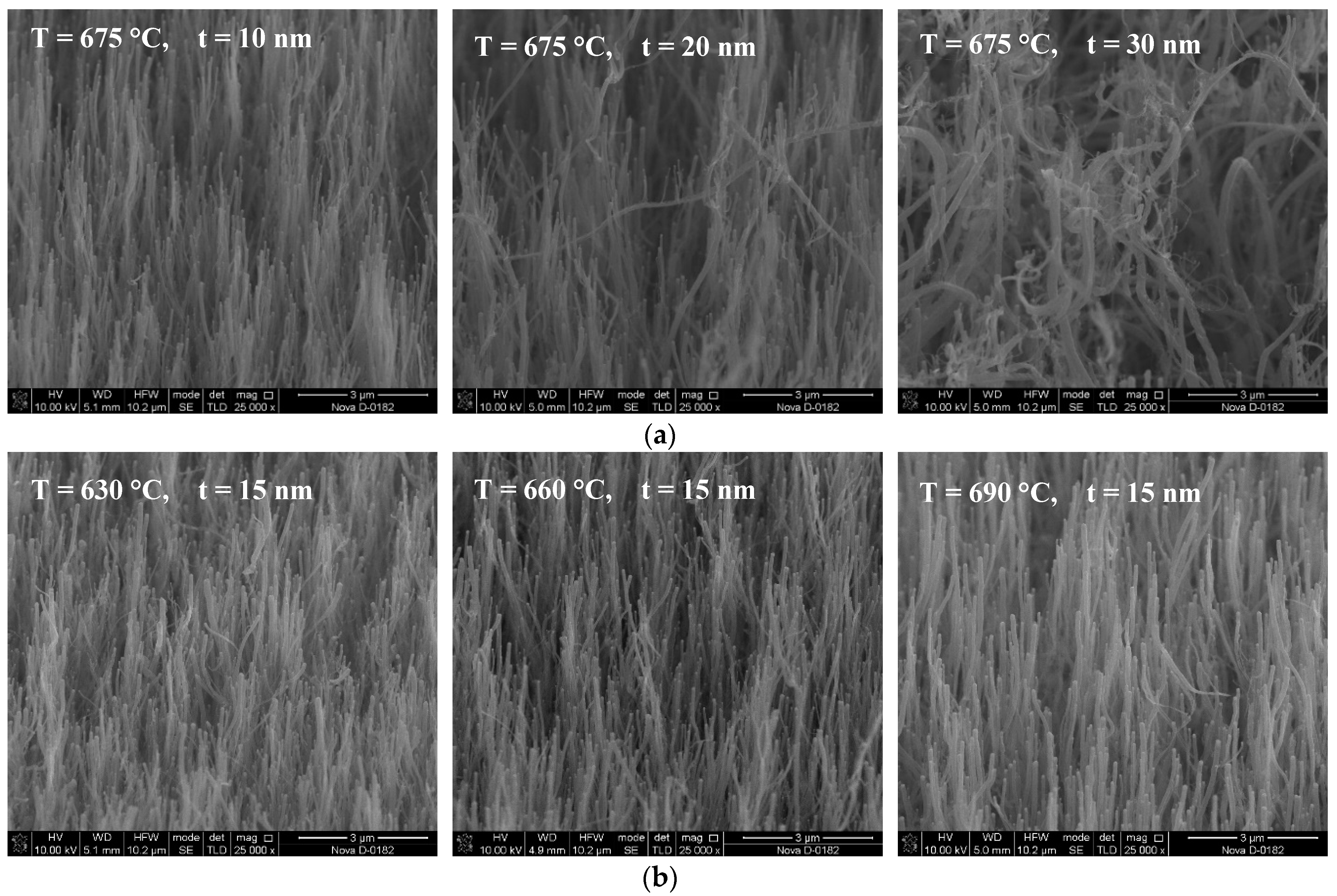
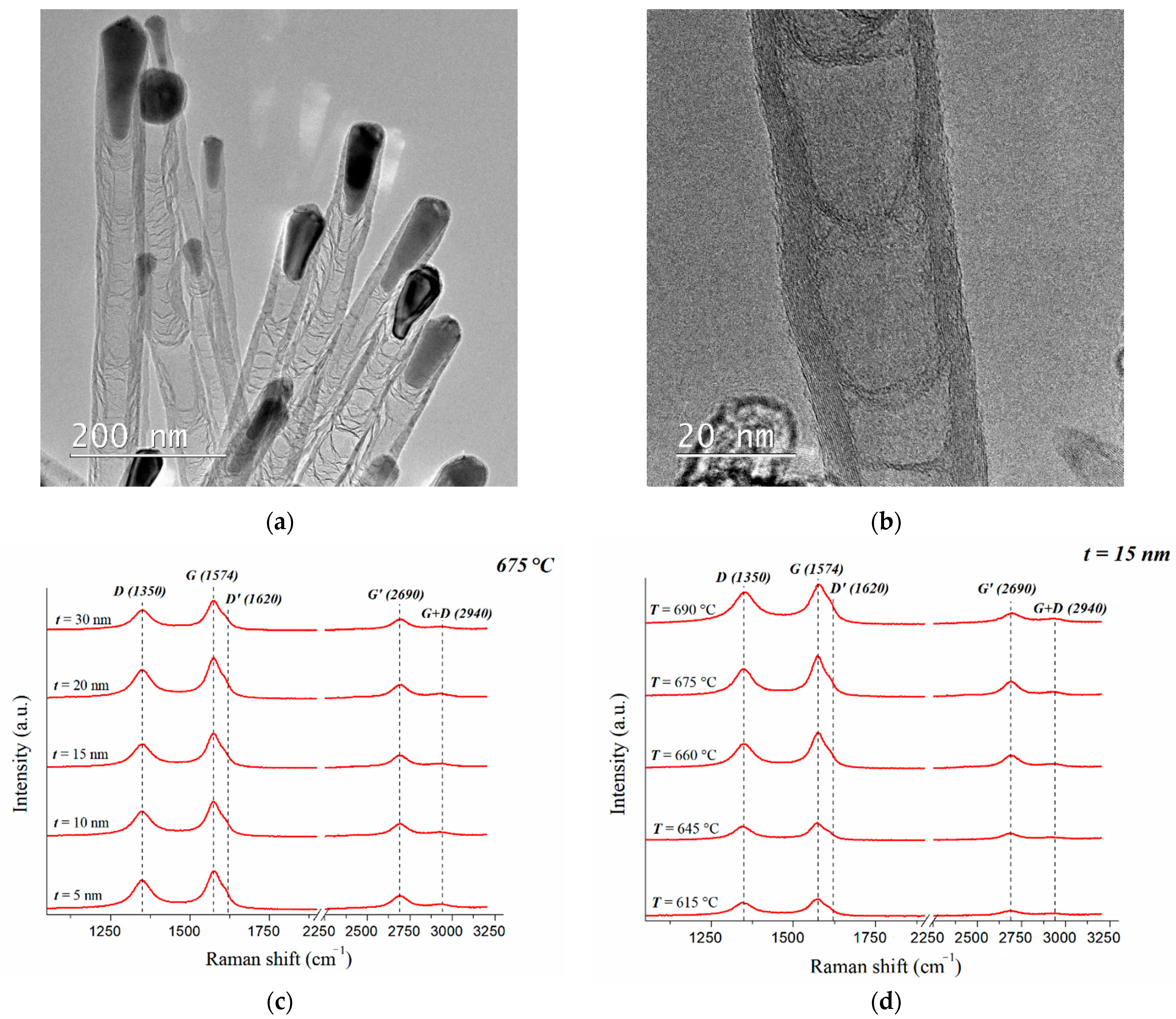

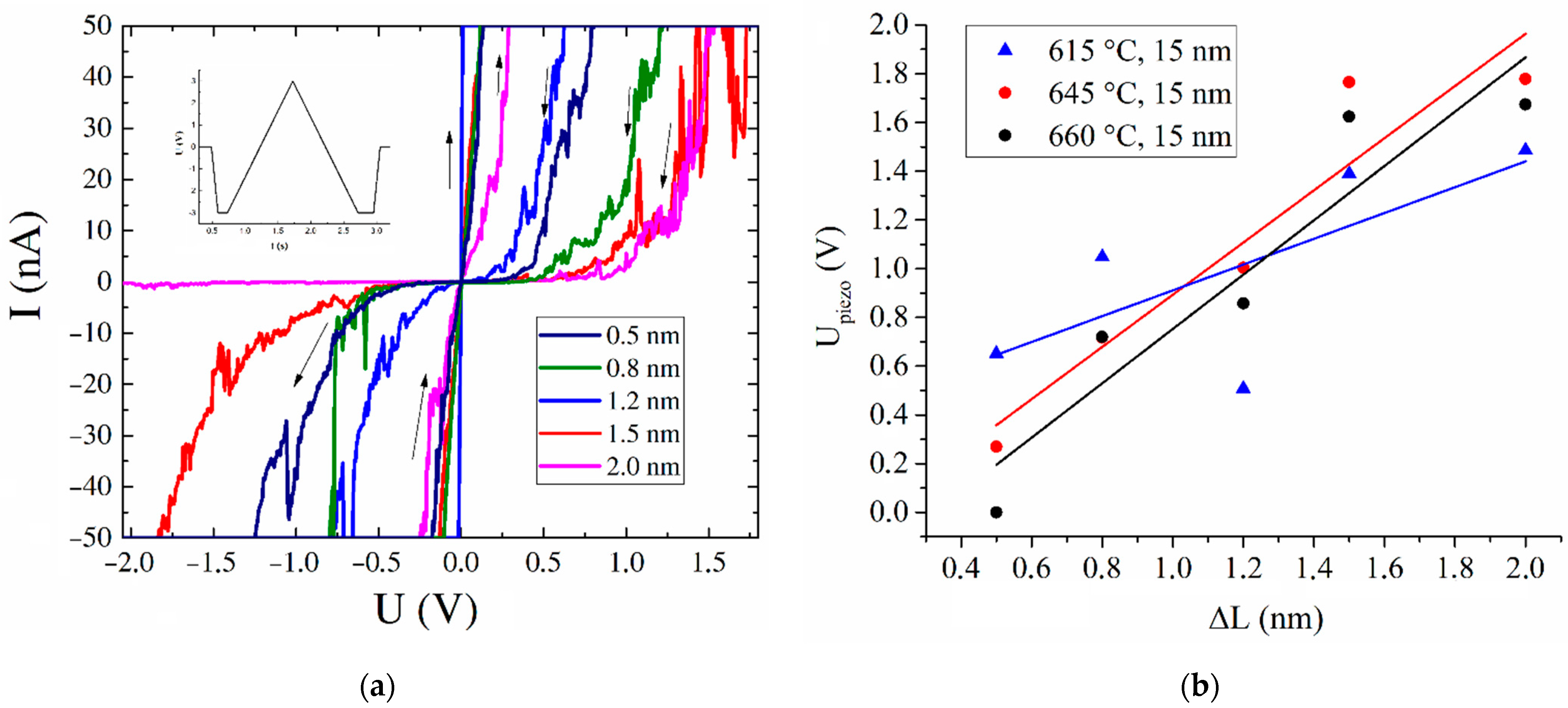

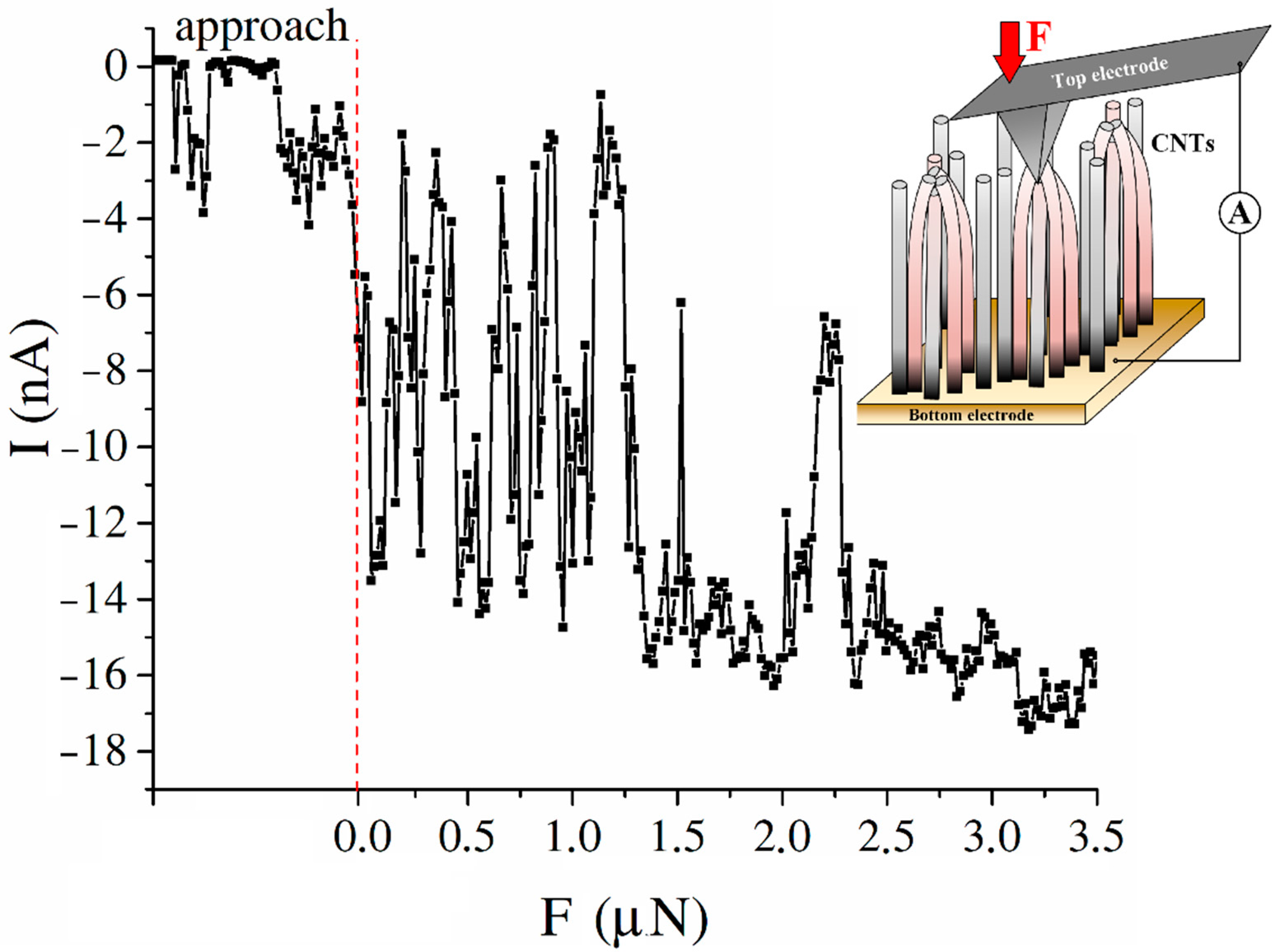
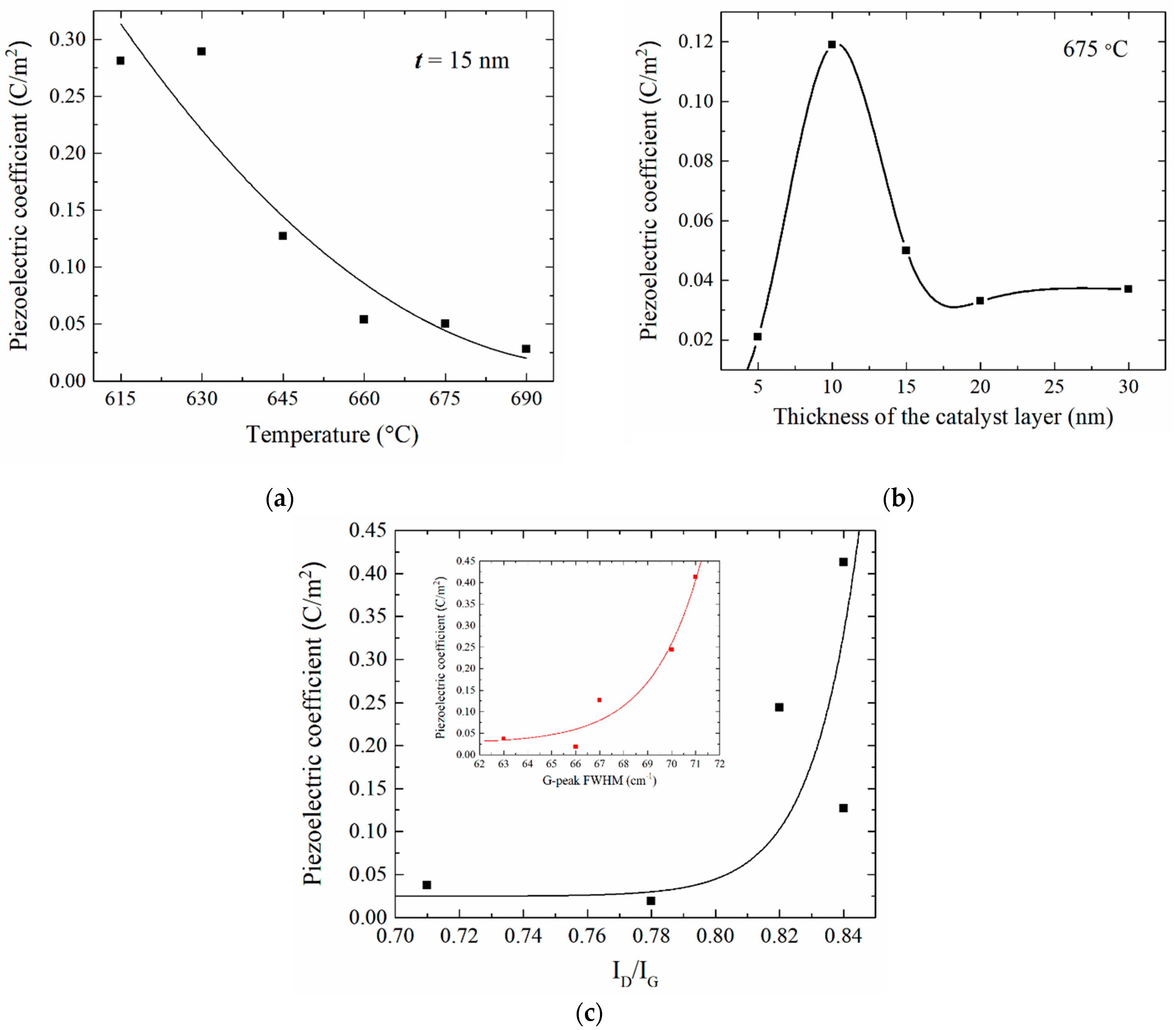
| CNT Growth Parameters | CNT Diameter (D), nm | CNT Length (L), μm | Piezoelectric Coefficient (e), C/m2 |
|---|---|---|---|
| Temperature at a catalytic layer thickness of 15 nm | |||
| 615 °C | 47 | 31.2 | 0.281 |
| 630 °C | 56 | 24.7 | 0.289 |
| 645 °C | 59 | 24.2 | 0.127 |
| 660 °C | 66 | 20.7 | 0.054 |
| 675 °C | 58 | 16.9 | 0.05 |
| 690 °C | 79 | 30.8 | 0.028 |
| Catalytic layer thickness Ni at a temperature of 675 °C | |||
| 5 nm | 62 | 11.3 | 0.021 |
| 10 nm | 48 | 18.0 | 0.119 |
| 15 nm | 58 | 16.9 | 0.05 |
| 20 nm | 63 | 19.6 | 0.033 |
| 30 nm | 64 | 10.7 | 0.037 |
| Mix of catalytic layer thickness and temperature | |||
| 615 °C, 5 nm | 32 | 8.3 | 0.413 |
| 630 °C, 10 nm | 44 | 24.2 | 0.244 |
| 645 °C, 15 nm | 59 | 24.2 | 0.127 |
| 660 °C, 20 nm | 88 | 22.3 | 0.019 |
| 690 °C, 30 nm | 92 | 40.5 | 0.297 |
Publisher’s Note: MDPI stays neutral with regard to jurisdictional claims in published maps and institutional affiliations. |
© 2021 by the authors. Licensee MDPI, Basel, Switzerland. This article is an open access article distributed under the terms and conditions of the Creative Commons Attribution (CC BY) license (https://creativecommons.org/licenses/by/4.0/).
Share and Cite
Il’ina, M.V.; Il’in, O.I.; Rudyk, N.N.; Osotova, O.I.; Fedotov, A.A.; Ageev, O.A. Analysis of the Piezoelectric Properties of Aligned Multi-Walled Carbon Nanotubes. Nanomaterials 2021, 11, 2912. https://doi.org/10.3390/nano11112912
Il’ina MV, Il’in OI, Rudyk NN, Osotova OI, Fedotov AA, Ageev OA. Analysis of the Piezoelectric Properties of Aligned Multi-Walled Carbon Nanotubes. Nanomaterials. 2021; 11(11):2912. https://doi.org/10.3390/nano11112912
Chicago/Turabian StyleIl’ina, Marina V., Oleg I. Il’in, Nikolay N. Rudyk, Olga I. Osotova, Alexander A. Fedotov, and Oleg A. Ageev. 2021. "Analysis of the Piezoelectric Properties of Aligned Multi-Walled Carbon Nanotubes" Nanomaterials 11, no. 11: 2912. https://doi.org/10.3390/nano11112912
APA StyleIl’ina, M. V., Il’in, O. I., Rudyk, N. N., Osotova, O. I., Fedotov, A. A., & Ageev, O. A. (2021). Analysis of the Piezoelectric Properties of Aligned Multi-Walled Carbon Nanotubes. Nanomaterials, 11(11), 2912. https://doi.org/10.3390/nano11112912








